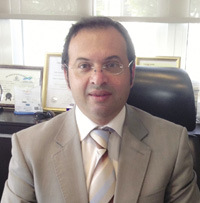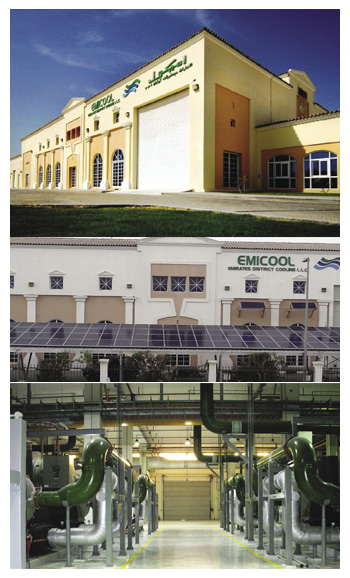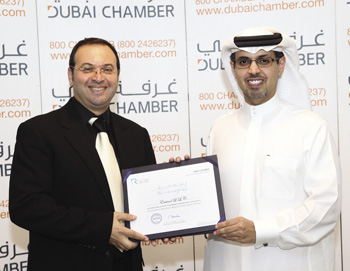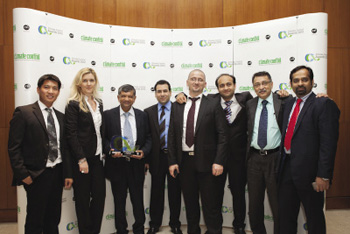Despite the glitches District Cooling faced in its early days, it is the most optimum air conditioning system, given the millions of square feet of buildings in the region, believes Adib Moubadder, CEO of Emicool, and gives an insider’s view of the industry in his chat with B Surendar.
Despite the glitches District Cooling faced in its early days, it is the most optimum air conditioning system, given the millions of square feet of buildings in the region, believes Adib Moubadder, CEO of Emicool, and gives an insider’s view of the industry in his chat with B Surendar.
 This seems to be the season of consolidation and expansion in the District Cooling industry. Is that the way forward, do you think?
This seems to be the season of consolidation and expansion in the District Cooling industry. Is that the way forward, do you think?
We at Emicool feel expansion is the way forward to achieve good results. We are working towards having a footprint in Qatar and Saudi Arabia.
There are different ways of expanding. If you look at it, expansion is about innovative thinking. For instance, we have worked out a model where you can have a District Cooling scheme of 2,000 TR. We can offer District Cooling to a single building and make it economically viable – it all depends on managing the installation and the cost of building the installation. It is about cost-saving to make it viable. You can build a capacity of 2,000 TR for about USD 1.5 million. I would rather build for less. Of course, I need end-users to be aware that they are dealing with a District Cooling concept. If one end-user is convinced about District Cooling, we would use that as a strength and approach his neighbour and connect. It is about tapping into a network that is available to us. So this is a sort of expansion.
Your approach sounds similar to Distributed Cooling. How viable is it when it comes to execution? Have you factored in issues relating to service corridors? And would there be a disruption of traffic?
Yes, there will be disruption of traffic, but we are asking people to take a bit of pain. And don’t forget, when we talk of a single end-user, it could be a mall. We see this approach working well with malls in Qatar. We have conducted studies to assess the possibilities.
And if we look at the benefits, there is value in adopting District Cooling. The cost of transforming can be offset by freeing valuable footprint. For instance, the roof can be cleared of all the chillers to make way for a gym. Plus, we would come up with incentives to connect to District Cooling, such as a discounted connection fee.
Another way of expanding is to buy small District Cooling plants. I am talking of capacities between 5,000 and 10,000 TR. As part of this type of expansion strategy, we have bought the Uptown Mirdiff District Cooling plant. In this approach, we would look to raise efficiencies by investing in controls, etc.
Overall, we have always been innovative in our approach to District Cooling. We were the first to do District Cooling for villas. This was in 2003. So we are adding value to the customers. We have explained to them the benefits of District Cooling. There is no noise in the neighbourhood, for one. And there is no heat that is being ejected in the area. In a conventional set up, the heat goes up and crosses a few metres and comes down, creating discomfort.
So overall, our expansion strategy is three-pronged – going into new geographical areas, a localised District Cooling scheme and buying smaller District Cooling plants and tapping into the existing networks.
 How much of idle capacity do you have?
How much of idle capacity do you have?
In terms of commissioned and running, we stand at 330,000 TR. Of that, I have energised 250,000 TR in peak summer. As part of our expansion drive, it will be 350,000 TR in 24 months, though, so in fact, I will be needing more capacity.
We are still in the market, because we are very conservative; I build on installment basis.
Now that we are seeing a construction boom in Dubai Sports City, which is my jurisdiction, I am optimistic. Overall, the geographic location I am working in is mature. The DIP area is from Emirates Road to Al Hibab Road, which spans 26 square kilometres. I have Motor City, so there is an escalation of square feet. Our business is square-foot driven.
We have managed to survive in the Great Recession, because we have strong contracts.
What is your customer profile looking like?
Our customers include hotels, labour camps, retail, hospitals and schools. I am working towards a more diverse customer profile that will include more of health and schools. We have very good R&D and are probably the only company that experiments and executes projects.
We also do home service for our customers. I drop prices by 50% and I remove their hitches and glitches though our FM AC service activities.
In terms of efficiency, do you have a scheme of rewarding the good customers?
We give incentives to customers for lowest consumption across various categories, be they one-bedroom or two-bedroom units.
We are pioneers in metering. We take efforts to convince customers to install sub-meters during the design stage. Consumption has dropped year on year. It has dropped 14.6% in Ewan Residences, for instance, ever since we started out with sub-metering.
In all, we have 17,000 sub-meters. They are all bar-coded through an ERP system. By the way, we have our own ERP system.
We have fibre optic, GPRS, and some of them are on F-signal. I don’t have to enter a building at all; the reading of the sub-meters is done remotely.

Adib Moubadder, CEO of Emicool, receiving the Dubai Chamber CSR Label certification from H.E. Hamad Buamim, Director General, Dubai Chamber
Still there is a general feelingb that District Cooling providers are not doing enough to support their customers. There is the nagging thought that some customers have to pay for the relative inefficiencies arising out of the deployment of temporary chillers? How is it with you?
In Dubai Sports City, we have temporary chillers, and that is because the piping network has not reached there. The plant is 2.4 kilometres away from Dubai Sports City. I have built the plant within the Sports City, and within a year the entire Sports City will be linked to the plant.
We are getting 1.2 kW/TR in the case of the temporary air-cooled chillers, but we are subsidising our customers. We are losing, but we are losing for one year, not for 25 years.
We do not impose penalties on our customers for low Delta T, but from a technical point of view, the losses we see, we have to impose it. If we don’t penalise, there will not be any corrective measures taken. And the penalty is not to make money for ourselves, but to pay to the grid.
At the same time, as mentioned earlier, we are giving incentives for low consumption. You have to be fair. That is why we are proposing that all the secondary networks have to be run by District Cooling providers, because FM companies are not equipped with the technology, expertise or the knowledge.
Coming back to my earlier question about consolidation, do you get a feeling you will be bought over?
As the CEO, I am not aware of any consolidation, of anyone wanting to buy Emicool. We had a lot of assets. Our debt-to-assets ratio was not right, and our restructuring efforts helped.
Our company is mature enough to take mega projects. People love to work with us. Our decision-making process is quick. We are on the right path.
Where are you from an environmental standpoint? With HCFC-related phase-out schedules approaching, are you prepared?

Emicool winning the ‘Best Utility Provider in District Cooling’ category at the Climate Control Awards 2012
About 75% of my equipment runs on R134A and about 25% on R123. We are working with Trane to find a more sustainable solution, and we have recovery units in place to reclaim and re-inject the gas. All our maintenance is on recovery units. We are working on the bearing type and doing carbon balancing. The mission is to overall reduce carbon emissions. To specifically answer your question, we will phase out R123 within 18 to 24 months.
We are very concerned about the need to safeguard the environment. We have thermal energy storage in all our plants, because I believe in sustainability.
What kind of efficiencies do you get across your plants?
I get 0.9kW/TR on an average. In some plants, I get 0.82.
What efforts do you take to conserve water?
We are installing sensors to check for leakages. From a macro point of view, all our plants are on treated sewage effluent (TSE), except in summer, when irrigation water is needed. We use 90% TSE and 10% DEWA water. All our plants work on RO.
As an industry player, are you concerned about the rather low penetration rate of District Cooling in the country? And more so, in the region?
Sooner or later, people will realise that District Cooling is the most optimum air conditioning system. We cannot deviate from a certain fact that District Cooling reduces power consumption and carbon emissions. The entire GCC economy is characterised by very good export of fuel. If the leaders of the region want to reduce domestic consumption, they have to use District Cooling. And that’s precisely why it’s part of the strategic energy plan of the Government of Dubai.
In Saudi Arabia, they know that District Cooling is the way forward, else there will be serious problems related to costs – I am referring to substation costs, grid network costs and low voltage to buildings.
While there is no questioning the virtues of District Cooling, provided it is done properly, there are consultants who are recommending standalone systems to their clients. What can be done to bring a change of heart?
The level of consulting in some quarters is below the desired standard. The consultants need to give proper answers to end-users. They are giving wrong recommendations owing to a traditional way of thinking. You cannot approach a country raising millions of square feet of buildings with a traditional mentality.
I agree that the cost of District Cooling was massive during the construction boom of the last decade, but costs are coming down. Overall, there is a need to allow the District Cooling industry to be as competitive as possible. So we need more players and ought not to be limited to one provider. The healthy model will be one where there is competition. I am against the thinking that says we need one company to deliver District Cooling to the whole of Dubai. District Cooling is not like electricity and water; it requires high technical finesse.
Copyright © 2006-2025 - CPI Industry. All rights reserved.